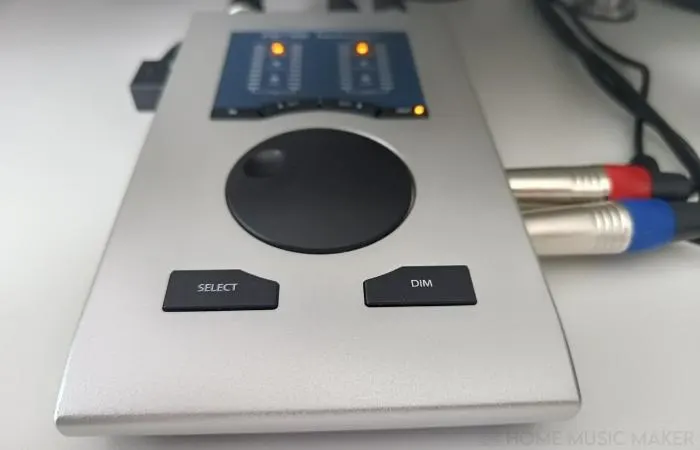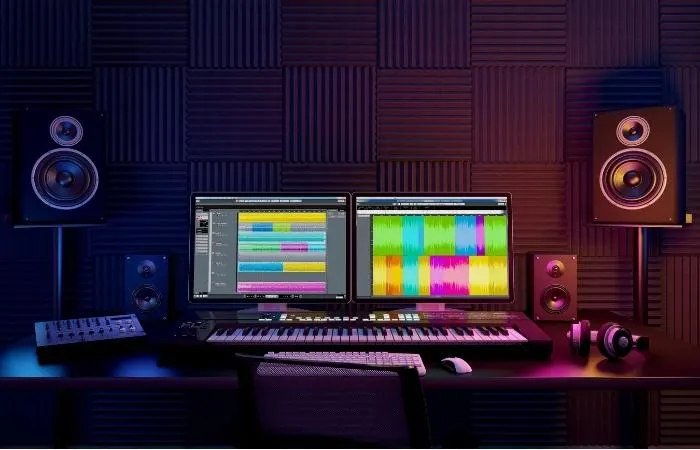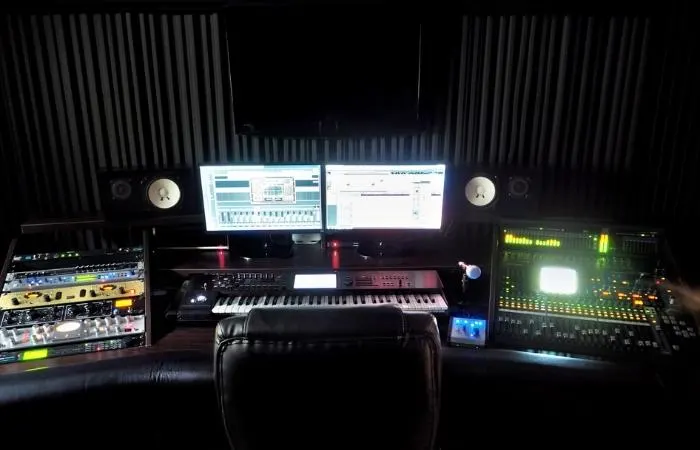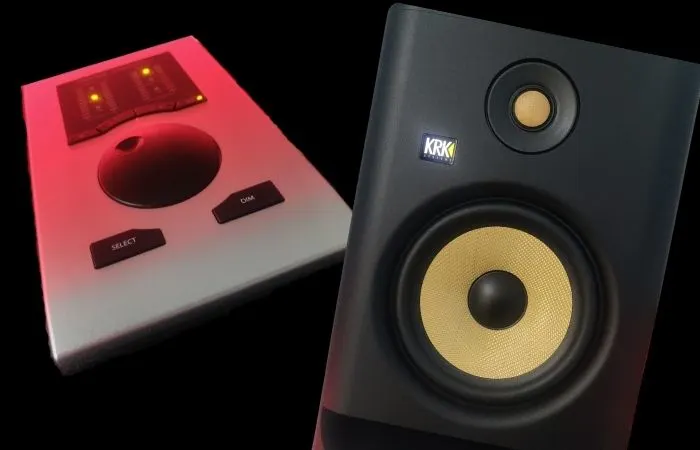Most professional studios do not actually use all-in-one off-the-shelf audio interfaces. Instead, they use different combinations of standalone equipment with the features found inside an interface. Any audio interfaces you find in a professional studio tend to be high-end and offer many additional features.
Audio Interfaces In Professional Studios
A Lot of times, Larger studios don’t use audio interfaces, at least not in the same way home studios might.
In reality, audio interfaces are just an “all-in-one” solution that packages up a few common audio circuits into one convenient box.
Still, you can also find these same circuits being sold as independent units.
Its a lot more common to find large professional studios that use different combinations of these standalone circuits, including:
- Preamps
- Digital to analog converters
- Analog to digital converters
- Gain stages
- Monitor controllers
- Plus more!
These are configured similarly to what’s happening inside an “all-in-one” interface.
This technique tends to be the most expensive. However, it provides a level of control and versatility that other solutions simply can not offer.
I will say, though, that for the most part, this is total overkill for a home recording studio setup, and a standard audio interface will be more than enough.
What Is The Industry Standard Audio Interface?
There is no one-size-fits-all answer to this question, as the industry standard audio interface will vary depending on the specific needs of your studio.
However, some of the most popular audio interfaces used in professional studios include the Universal Audio Apollo, the Focusrite Scarlett, and the RME Babyface Pro.
Before we look at some audio interface options later in this article, and some tips on choosing one, let’s first look at why an audio interface is needed.
Why Do You Need An Audio Interface In A Studio?

First and foremost, it’s essential to understand what an audio interface is and what it’s used for.
An audio interface is a device that allows you to connect musical instruments and other audio devices to your computer.
This way, you can record and playback audio on your computer.
Various audio interfaces are available on the market, ranging from simple, single-channel devices to more complex, multi-channel units.
The type of audio interface you need will depend on your studio’s specific recording and playback needs.
Best Audio Interface For Professional Recording Studio
Smaller Professional Studios

Universal audio Is an absolute must-have for smaller studios.
This is because Universal Audio is well known for making some of the best VST plugins on the market. To run these plugins, you need to own a Universal Audio Interface.
When I say some of the best plugins on the market, I mean it!
They make many highly accurate analog emulations.
Due to the nature of analog VS digital, these emulations take a lot of computing power to run. So what Universal audio did essentially was to build a super-fast minicomputer (called a DSP processor) inside their audio interfaces.
So when you use a Universal Audio plugin, it gets offloaded to the processor in the interface, leaving your main computer free to do what it usually does and run your DAW/instruments/everything else.
This is mainly popular in smaller studios because larger, more established studios tend already to own a lot of these analog hardware units that Universal Audio is trying to emulate, so there is no need for them.
Mid-Sized Professional Studios

This is where you will see a lot of brand names known in the home studio/budget market. Brands like Antelope audio, Focusrite, Avid, and RME are a few.
A mid-sized studio will often have one of their flagship boxes, usually with at least 16×16 channels of in/out, respectively.
Common features for an interface at this price point include:
- Phantom power
- MIDI I/O
- Built-in preamp
- Amazing audio quality
It’s hard to say which is the “best” because it will come down to your specific needs as a studio.
The main thing you want to look for is low latency performance and stability.
- Latency is the time it takes for the signal to travel from your input (microphone/guitar/etc.), through the interface, and out to your monitors.)
- Stability refers to the drivers (the software that allows the hardware to communicate with your computer).
What To Look For In A USB Audio Interface
When choosing an audio interface for your professional recording studio, remember a few things.
First, you’ll want to make sure that the audio interface has enough audio input and outputs for all of your music production equipment.
You’ll also want to ensure that the audio interface is compatible with your DAW(Ableton, Studio One, FL Studio, etc.)
Finally, you’ll want to ensure the audio interface has the features you need.
How Do I Choose An Audio Interface?
When choosing an audio interface, it’s essential to consider the specific needs of your studio.
Some factors to consider include:
- The type of audio devices you plan on connecting
- The number of channels you need
- Your budget
A lot of the time, the main difference between a budget interface and a mid-priced one is the quality of the mic preamp.
So if you plan on doing a lot of recording and need a high-quality mic preamp, you might want to look into something a bit more expensive.
Mic Preamps
An audio interface typically contains one or more mic preamps. The mic preamp is responsible for boosting the signal from your microphone or instrument so that it can be appropriately converted into digital form by the ADC (analog-to-digital converter).
Mic Preamps can vary widely in terms of sound quality—the better the preamp, the better the overall sound quality of your recordings.
Analog To Digital Converters(ADC)
The ADC is responsible for converting the analog signal from your microphone preamp or instrument into digital form, so your computer can process it.
The digital converter’s quality will directly impact the audio quality of your home recording.
Digital-To-Analog Converters (DACs)
DACs are responsible for converting the digital signal from your computer into an analog form so that it can be amplified and played back through speakers or headphone output.
How To Choose The Right Audio Interface?
Now that you know what to look for in an audio interface, you’ll need to choose the right one for your recording studio.
The first step is to determine your budget. Once you’ve done that, you can start looking at different audio interfaces. You’ll want to read reviews and compare prices before making your final decision.
Do I Need An Audio Interface For Studio Monitors?

In most cases, yes.
If you plan on using a studio monitor in your studio, you will need an audio interface that can connect to your monitors.
Some audio interfaces even come with built-in amplification, making them ideal for use with studio monitors.
Is An Audio Interface Necessary For Home Studio?
While an audio interface is not strictly necessary for a home studio, it will significantly improve the sound quality of your home recording.
An audio interface will also allow you to connect a broader range of audio devices to your computer through MIDI I/O or the line input.
Are High-End Audio Interfaces Worth It?
This is a difficult question to answer, as the value of a high-end audio interface will vary depending on the specific needs of your studio.
In general, high-end audio interfaces offer better sound quality and lower latency than their budget-priced counterparts.
What Does An Audio Interface Do?
An audio interface is a device that allows you to connect musical instruments and other audio devices to your computer.
This way, you can record and playback audio on your computer. Audio interfaces vary in terms of features and price. Still, all offer a way to improve the sound quality of your recordings.
How Much Should I Spend On An Audio Interface?
Again, this is another difficult question to answer, as the amount you should spend on an audio interface will vary.
Generally, you can expect to spend anywhere from $100 to $1000 on an audio interface.
Do I Really Need A Mic Preamp In My Studio To Make A Good Record?
A mic preamp is unnecessary in your studio if you have a good audio interface. However, a mic preamp can help you get the most out of your studio microphones.
If you have a professional recording studio, a mic preamp will allow you to connect your studio microphones to your audio interface.
Best Audio Interfaces For Home And Professional Studios
The following audio interfaces are some of my top picks for home studios.
I have tried to select a variety of interfaces to fit different budgets and needs.
Focusrite Scarlett 2i2
The Focusrite Scarlett 2i2 is an excellent option for home studios on a budget.
It’s a simple interface with two inputs and two outputs, making it perfect for recording one or two tracks simultaneously.
It’s a fantastic starter interface and is popular among home studios for its low price and high performance.
Focusrite Scarlett 18i8
The Focusrite Scarlett 18i8 is a great option for those who want a more advanced interface.
It’s a larger interface with eight inputs and eight outputs, making it perfect for recording multiple tracks at the same time.
Universal Audio Apollo Twin MKII
The Universal Audio Apollo Twin MKII is the perfect audio interface for those who want to record high-quality audio.
It has two inputs and two outputs, allowing you to connect two microphones or instruments at once.
The interface also has a headphone output to monitor your recordings.
Native Instruments Komplete Audio 6
The Komplete Audio 6 from Native Instruments is a fantastic audio interface for anyone interested in recording and producing music.
The unit is well built and has a great feature set, including four inputs, two outputs, and MIDI I/O.
The audio quality is excellent, and the unit has a good selection of software to get you started.
Steinberg UR22MKII
The Steinberg UR22MKII is an excellent budget interface.
It’s simple to use and sounds great.
The only downside is that it doesn’t have any Thunderbolt support, so if you’re looking to use it with a Mac, you’re out of luck.
RME Babyface Pro FS
Finally, we have the audio interface I use in my studio, and I love it! The RME Babyface Pro FS. With its twelve I/O (24 channels in total) and mic/instrument preamps, you are never short of channels.
It looks incredible and is manufactured out of a single aluminum block.
On top of this, you get the TotalMix FX software and Digicheck spectrum analyzer, which are market leading.
I can’t recommend the Babyface pro enough in a home or professional studio.
Its downside is it’s not cheap! But you definitely get what you pay for!
Final Words
There isn’t just one go-to interface for professional studios.
Which is best will vary depending on your specific needs in music production.
There are also quite a few aspects that should be considered when choosing an audio interface for your needs.
This piece of gear can be complex, but hopefully, now you should be well on your way to understanding how to find the best audio interface for professional studios.
Click here for an in-depth rundown of our top audio interfaces.







 Want to connect with other music producers for help and guidance?
Want to connect with other music producers for help and guidance?